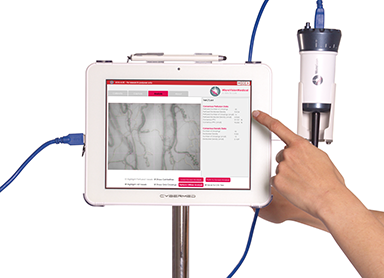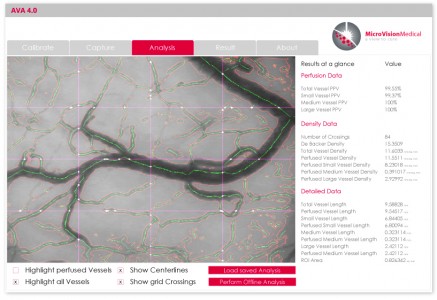MicroScan employs a completely redesigned imaging technology called SDF+ as well greatly enhanced data acquisition and analysis algorithms in the latest version of the MicroScan software application called AVA 5.
The combination of SDF+ and AVA 5 results in the immediate routine use of the microcirculation as an easily monitored parameter in the clinic.
The technology is easy to use, intuitive and fast allowing a nurse to take it on rounds for regular patient checkups. Moreover, it provides reliable, consistent and reproducible data that adheres fully to the rules of the internationally accepted consensus scoring guidelines.
MicroVision Medical has a strong focus on high quality imaging, thus allowing for only the best possible images to be presented to the user and the analysis software. Leading the innovations is the age old scientific adagium “garbage in = garbage out”. Therefore the USB3 MicroScan has numerous changes and improvements that allow for superior image quality and highly accurate, reliable and reproducibly image acquisition and analysis.
First and foremost the new SDF+ technology allows the red blood cells to be visualised with greater accuracy and detail, which is essential for enhancing the capabilities of the analysis application. The main innovations of SDF+ are a new form of illumination management and resolution enhancement. The USB3 MicroScan has an increased optical resolution resulting in one pixel recording an area of 0.56 μm2 ! It is this level of detail that allows the USB3 MicroScan achieve superior and leading image quality and analysis accuracy.

MicroVision Medical has worked extensively with intensive care nurses and physicians to deliver the best possible software solution for their needs. Our new AVA 5 has a completely new user interface that includes step-by-step guidance for image acquisition and fully automatic image analysis.
MicroVision Medical has proven that AVA 5 will revolutionise microcirculation monitoring at the bed side. A complete measurement takes less than 5 minutes! This includes the time for an operator to capture images at three sites and the fully automatic analysis.
A real time video of AVA 5 can be viewed here.

There is currently no other analysis tool available that can fully automatically analyse microcirculatory images.
Request a quote for the MicroScan System, sterile disposables and/or AVA software by filling in a simple form. We aim to respond within 1 working day.
Here you find the latest articles on microcirculation & the use of the SDF technique. If you are looking for articles in a specific field of interest you can contact us here.
Semin Respir Crit Care Med. 2011 Oct;32(5):558-68. Abstract Largely ignored throughout the history of clinical medicine, the microcirculation has recently been recognized at the bedside as the center of several pathophysiological processes. Normal microcirculatory function is critical for adequate tissue oxygenation and organ function, but it has a poorly understood and highly heterogeneous structure that is related to the diversity of functions that it accomplishes. The most important function of the microcirculation is the regulation and distribution of oxygen carrying red blood cells within the different organs. The determinants of oxygen delivery, blood flow regulation, tissue oxygen tension, and mitochondrial well-being are not fully understood; however, it is clear that insight into the function of the microcirculation is key in this respect. In fact, it is clear that the origin of circulatory failure in critical illness unresponsive to therapy is not represented in systemic hemodynamic variables but rather in the dysfunction of the microcirculation. The introduction of bedside techniques into clinical practice that allow the evaluation of the microcirculation has opened up a new field of functional hemodynamic monitoring, identified the microcirculatory failure as the most sensitive indicator of circulatory failure associated with adverse outcome, and has provided the promise of identifying new therapeutic targets. Clinical research has identified various conventional and new therapeutic approaches that are successful in modifying the microcirculation. Current research must determine whether some of these approaches are successful in improving the outcome of critically ill patients by recruiting the microcirculation. Read the Abstract in PubMed
Shock. 2010 Apr;33(4):387-91 || Conclusions: Efforts to improve survival from sepsis are focusing increasingly on intervention during the earliest stages of this disease. The importance of derangements in microvascular flow in patients with established sepsis is well recognized. However, little data are available to describe microvascular changes in early sepsis. After research ethics committee approval, observational data were collected in healthy volunteers and within 6 h of presentation in patients with sepsis and severe sepsis. Sidestream dark-field imaging was used to obtain video images of the sublingual microcirculation. Cardiac index was measured using the noninvasive suprasternal Doppler method. Forty-eight patients and 16 healthy volunteers were recruited. Twenty-eight patients were diagnosed with sepsis and 19 with severe sepsis. Eight patients (17%) did not survive to leave hospital. For small vessels (<20 microm), microvascular flow index (P < 0.05), heterogeneity index (P < 0.05) and the proportion of perfused vessels (P < 0.05) were lower in patients with sepsis and severe sepsis compared with healthy volunteers. Perfused vessel density (P < 0.05) was lower in the severe sepsis group compared with the sepsis group. The proportion of perfused vessels (P < 0.01) and MAP (P < 0.05) were lower in nonsurvivors compared with survivors. Sepsis results in derangements of microvascular flow, which can be identified in the early stages of this disease. These abnormalities are more marked in the most severely ill patients. Further research is required to fully characterize the effects of sepsis on microvascular function.
J Crit Care. 2012 Oct;27(5):531.e1-7 || Conclusions: In this cohort of patients with hemodynamic instability, we observed discordance between microcirculatory blood flow and arterial pressure. These data support the concept that microcirculatory blood flow indices can yield physiologic information distinct from macrocirculatory hemodynamic parameters. Read the abstract in PubMed